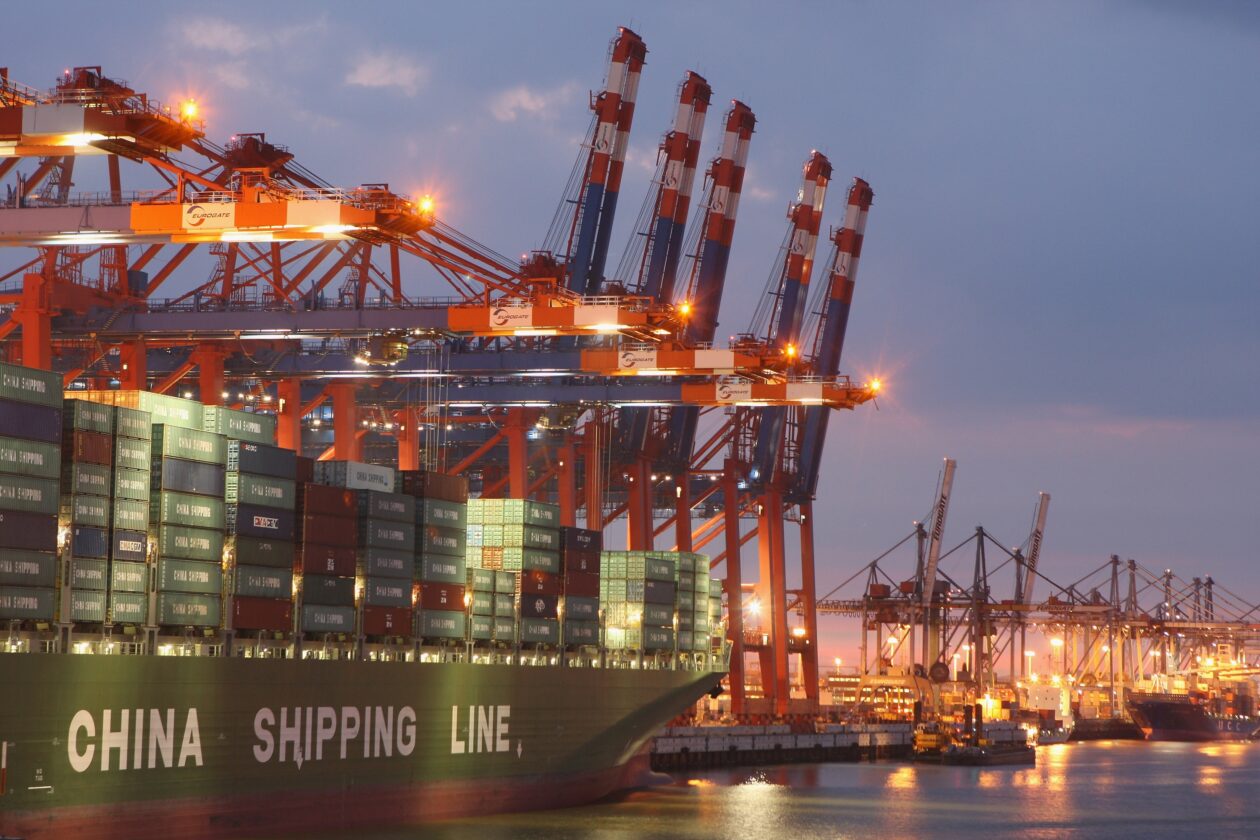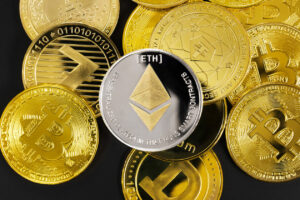Bitcoin edged up on Tuesday morning in Asia after U.S. multinational payment giant PayPal launched a U.S. dollar-pegged stablecoin on Monday. Ether was still treading water, however, as all other top 10 non-stablecoin cryptocurrencies traded flat to lower. Dogecoin led the losers. Meanwhile, the Forkast 500 NFT index rose, as NFT trading volume also picked up. U.S. stock futures traded flat after Wall Street closed higher on Monday, as investors await the release of U.S. inflation data Thursday.
Pivotal role for PayPal stablecoin?
Bitcoin edged up 0.28% in the last 24 hours to US$29,133.55 as of 07:30 a.m. in Hong Kong but remained down 0.25% for the week, according to CoinMarketCap data. The world’s leading cryptocurrency briefly dropped to a low of US$28,724.14 on early Tuesday morning.
Digital asset investment products saw outflows totaling US$107 million in the week ending August 4, according to a Monday report by European alternative asset manager CoinShares. That marked the fourth consecutive week of outflows as profit taking gathered pace in recent weeks.
Bitcoin-related products saw weekly outflows totaling US$111 million, the largest for a week since March. However, outflows into Bitcoin short positions stopped for the first time in the past 14 weeks, according to the CoinShares report. Allowing investors to profit when the token’s price drops, the report’s authors said that the stall in short position outflows suggests institutional investors may be adjusting their Bitcoin strategies.
Ether dipped 0.13% to US$1,824.53, and lost 1.72% over the past seven days.
Paypal ramped up its efforts in the Web3 space by launching the PayPal USD (PYUSD) stablecoin on Monday. The Ethereum-based token is issued by Paxos Trust Company — the U.S.-based issuer of Binance’s BUSD stablecoin — and is fully backed by U.S. dollar deposits, short-term U.S. treasuries and similar cash equivalents.
Paypal’s stablecoin project was reportedly halted in February 2023 amid increased scrutiny from U.S. regulators toward stablecoins — including an order for Paxos to stop minting BUSD.
“PayPal’s news today is a testament to the burgeoning popularity of DeFi,” said Tony Petrov, chief legal officer at identity verification platform Sumsub.
The move highlights the “pivotal role” to be played by stablecoins as a bridge between digital and fiat currencies, Petrov continued. “This rapid ascent signals a major transformation in the cryptocurrency ecosystem, and the potential impact of stablecoins on the global financial landscape is an exciting development to monitor closely,” he added.
Other top 10 non-stablecoin cryptocurrencies all traded lower, with Dogecoin leading the losers. The meme token dropped 1.65% to US$0.07325 and logged a weekly loss of 5.86%.
The month of July saw a decrease in crypto trading activities, with Bitcoin volume decreasing 13.1% during the month, Ether falling by 21.9% and stablecoins volumes down 12.3%.
“The data emphasizes a moment of low activity in the market, which follows a strong uptrend in the first half of 2023,” said Greco, research analyst at Canada-based digital asset and fintech investment firm Fineqia International.
“Summer months are notoriously among the ones with the lowest level of trading activity and 2023 data are perfectly aligned with historical metrics on the matter. The overall outlook for 2023 remains extremely positive so far as the institutional / service providers’ news seen in the past few weeks still indicates strong interest towards the market,” Greco added.
For Greco, signs of that interest include multiple applications in the U.S. for exchange-traded funds (ETF) for Bitcoin and Ether. He also pointed to Hong Kong, where regulators have granted crypto exchanges HashKey Exchange and OKX licenses to offer crypto trading services to retail investors.
The total crypto market capitalization edged up 0.11% in the past 24 hours to US$1.16 trillion, while trading volume gained 59.07% to US$32.76 billion.
Tremors of NFT excitement following PayPal news
The main Forkast 500 NFT index gained 0.62% in the past 24 hours to 2,478.88 as of 10:50 a.m. in Hong Kong. However, it was still down 1.36% lower for the week. Forkast’s Ethereum, Solana, Polygon and Cardano indexes logged losses.
Total NFT trading volume rose 15.80% in the past 24 hours to US$13.09 million, according to data from CryptoSlam. The volumes on Ethereum, Solana, Polygon, Bitcoin and Cardano blockchains all logged increases.
“Paypal announcing the launch of a stablecoin has excited the NFT market a bit, as they look forward to an easy way to onboard the masses to crypto,” said Yehudah Petscher, NFT strategist for Forkast Labs.
However, NFT trading activity remains downbeat compared to the meteoric highs of late 2021 and 2022. Total NFT trading volume last week totaled US$87.76 million, over 60% lower than the start of the year, according to CryptoSlam.
“Now, sales volume is clearly lower. (But) It’s not the only measurement of growth,” said Petscher in a Youtube video posted Monday. Unique buyers, unique sellers and total transactions have all grown considerably since this time two years ago, he added.
“But the ecosystem has matured. The NFTs are getting cheaper. The supply is getting greater. It’s a different space. And it’s exactly what we need to reach the masses,” Petscher said.
In terms of NFT collections, Mythos Chain-based NFT marketplace DMarket posted the largest 24-hour trading volume but still dipped 4.48% to US$931,685. ImmutableX-based Gods Unchained Cards and Ethereum-based Mutant Ape Yacht Club (MAYC) ranked second and third.
Grails IV, the latest NFT collection issued by NFT startup Proof, started minting on Monday. The collection features artwork from 20 artists whose identities will be revealed when minting is completed Friday.
“Proof’s Grails IV collection has started minting, so expect some movement with art in general as collectors welcome some new future grails to their wallets. Artists will reveal soon which should add some excitement to the space,” said Petscher.
China export woes and more US rate hikes ahead?


U.S. stock futures traded lower as of 11:50 a.m. on Tuesday in Hong Kong after the three major U.S. stock indexes closed higher in regular trading on Monday.
In Asia, the main stock indexes were mixed on Tuesday morning. China’s Shanghai Composite and South Korea’s Kospi remained flat, Japan’s Nikkei logged gains, while Hong Kong’s Hang Seng dropped.
Amid the U.S. second-quarter reporting season, 79% of S&P 500 companies have released earnings higher than analyst expectations. That is the highest beat rate since the third quarter of 2021, Reuters reported on Monday citing data from Refinitiv.
Investors now await U.S. consumer price index (CPI) data on Thursday. Analysts expect core CPI to rise 0.2% in July, which would be the smallest monthly increase in the past two and a half years.
Meanwhile, U.S. Federal Reserve Governor Michelle Bowman said on Monday that multiple interest rate hikes may still be needed to curb inflation.
“We have made progress in lowering inflation over the past year, but inflation is still significantly above the FOMC’s two percent target, and the labor market continues to be tight, with job openings still far exceeding the number of available workers,” said Bowman in a Monday speech.
“Given these developments, I supported raising the federal funds rate at our July meeting, and I expect that additional increases will likely be needed to lower inflation to the FOMC’s goal,” said Bowman.
The Fed meets on September 19 to make its next move on interest rates, which are now between 5.25% to 5.50%, the highest level in the past 22 years. Analysts at the CME FedWatch Tool predict a 86.5% chance there will be no interest rate hike in September, and a 13.5% chance the Fed will raise rates by a further 25-basis-points.
Elsewhere, China’s exports in July slid 14.5% year-on-year to US$201.16 billion. Imports also posted an annual decrease of 12.4%, Chinese state media Xinhua News Agency reported on Tuesday.
As the country attempts to support its economic recovery by stimulating domestic demand, the drop in July exports was the biggest decline since February 2020. The figure fell well below analyst expectations.
“The government policy so far has changed but more on the property sector, and not much on boosting demand,” Zhang Zhiwei, chief economist at Pinpoint Asset Management Ltd, told Bloomberg. “So the economic situation is still quite challenging.”
(Updates to add equities section.)
- SEO Powered Content & PR Distribution. Get Amplified Today.
- PlatoData.Network Vertical Generative Ai. Empower Yourself. Access Here.
- PlatoAiStream. Web3 Intelligence. Knowledge Amplified. Access Here.
- PlatoESG. Automotive / EVs, Carbon, CleanTech, Energy, Environment, Solar, Waste Management. Access Here.
- BlockOffsets. Modernizing Environmental Offset Ownership. Access Here.
- Source: https://forkast.news/bitcoin-up-paypal-stablecoin-launch/
- :has
- :is
- :not
- :where
- ][p
- $UP
- 07
- 1
- 10
- 11
- 12
- 13
- 14
- 15%
- 16
- 19
- 2%
- 20
- 2020
- 2021
- 2022
- 2023
- 22
- 24
- 30
- 50
- 500
- 53
- 7
- 8
- 9
- a
- Able
- above
- According
- activities
- activity
- add
- added
- Additional
- After
- agency
- ago
- ahead
- aligned
- All
- Allowing
- also
- alternative
- Amid
- among
- an
- analyst
- Analysts
- and
- Announcing
- annual
- APE
- ARE
- Art
- Artists
- artwork
- AS
- asia
- asset
- asset management
- Assets
- At
- Attempts
- AUGUST
- authors
- available
- await
- backed
- BE
- been
- below
- between
- Biggest
- Billion
- Binance’s BUSD
- Bit
- Bitcoin
- Bitcoin volume
- blockchains
- Bloomberg
- boosting
- BRIDGE
- briefly
- BUSD
- but
- buy
- buyers
- by
- capitalization
- Cardano
- Cards
- Cash
- cash equivalents
- challenging
- Chance
- changed
- cheaper
- chief
- Chinas
- chinese
- Choose
- clearly
- closed
- closely
- club
- CNN
- CO
- CoinShares
- collection
- collections
- collectors
- COM
- Companies
- company
- compared
- Completed
- consecutive
- consumer
- consumer price index
- continued
- continues
- Core
- country
- CPI
- crypto
- Crypto Exchanges
- Crypto Market
- crypto trading
- Crypto trading services
- cryptocurrencies
- cryptocurrency
- cryptocurrency ecosystem
- CryptoSlam
- currencies
- data
- Days
- Decline
- decrease
- DeFi
- Demand
- deposits
- designed
- Development
- developments
- DID
- different
- digital
- Digital Asset
- Dogecoin
- Dollar
- Domestic
- down
- Drop
- dropped
- Drops
- during
- Early
- Earnings
- easy
- Economic
- economic recovery
- Economist
- ecosystem
- efforts
- emphasizes
- Equities
- equivalents
- ETF
- Ether
- ethereum
- Ethereum-based
- European
- exactly
- exchange
- exchange-traded
- Exchanges
- excited
- Excitement
- exciting
- expect
- expectations
- export
- exports
- extremely
- Falling
- far
- Features
- February
- February 2020
- Fed
- Federal
- Federal Funds Rate
- federal reserve
- federal reserve governor
- few
- Fiat
- fiat currencies
- Figure
- financial
- fintech
- FinTech investment
- Firm
- First
- first time
- flat
- following
- follows
- For
- Forkast
- Forward
- Fourth
- Friday
- from
- fully
- funds
- further
- future
- Futures
- gained
- Gains
- gathered
- General
- getting
- giant
- Global
- global financial
- goal
- GODS
- Gods Unchained
- Government
- Government policy
- Governor
- greater
- grown
- Growth
- Half
- hashkey
- Have
- he
- higher
- highest
- highlights
- highly
- Highs
- Hike
- Hikes
- historical
- hold
- Hong
- Hong Kong
- hour
- HOURS
- However
- HTML
- http
- HTTPS
- i
- identities
- Identity
- Identity Verification
- Impact
- imports
- in
- include
- Including
- Increase
- increased
- Increases
- index
- indexes
- indicates
- inflation
- Institutional
- institutional investors
- interest
- INTEREST RATE
- interest rate hike
- INTEREST RATE HIKES
- Interest Rates
- into
- investment
- Investors
- Issued
- Issuer
- IT
- ITS
- Japan’s
- Job
- jpg
- July
- Kong
- Korea’s
- labor
- labor market
- Labs
- landscape
- largest
- Last
- Late
- latest
- launch
- launched
- leading
- LEARN
- Led
- Legal
- less
- Level
- licenses
- likely
- Liquid
- logged
- Look
- Losers
- loss
- losses
- lost
- Low
- lower
- lowering
- lowest
- lowest level
- Ltd
- made
- Main
- major
- make
- managed
- management
- manager
- March
- marked
- Market
- Market Capitalization
- marketplace
- masses
- Matter
- max-width
- May..
- mayc
- Meanwhile
- measurement
- measures
- Media
- meeting
- Meets
- meme
- Meme Token
- meteoric
- Metrics
- million
- minted
- minting
- mixed
- moment
- Monday
- Monitor
- Month
- monthly
- months
- more
- morning
- move
- movement
- much
- multinational
- multiple
- Mutant Ape Yacht Club
- Mutant Ape Yacht Club (MAYC)
- Need
- needed
- New
- news
- next
- NFT
- NFT collection
- NFT collections
- nft market
- nft marketplace
- NFT trading
- NFTs
- no
- non-stablecoin
- now
- number
- of
- offer
- Officer
- OKX
- on
- Onboard
- ones
- only
- opened
- openings
- Other
- our
- out
- outflows
- Outlook
- over
- overall
- Pace
- past
- Paxos
- payment
- payments
- PayPal
- percent
- perfectly
- performance
- picked
- pieces
- platform
- plato
- Plato Data Intelligence
- PlatoData
- played
- policy
- Polygon
- popularity
- position
- positions
- positive
- posted
- potential
- predict
- price
- Products
- Profit
- Progress
- project
- proof
- property
- proxy
- Quarter
- raise
- raising
- ranked
- rapid
- Rate
- Rate Hike
- rate hikes
- Rates
- reach
- recent
- recovery
- refinitiv
- regular
- Regulators
- release
- released
- remained
- remains
- report
- Reporting
- research
- Reserve
- retail
- Retail Investors
- Reuters
- reveal
- Revealed
- Rise
- Role
- Rolling
- ROSE
- s
- S&P
- S&P 500
- Said
- sales
- Sales Volume
- saw
- scrutiny
- Season
- Second
- Section
- sector
- secure
- seen
- sell
- Sellers
- September
- September 19
- service
- Services
- seven
- Short
- short-term
- should
- signals
- significantly
- Signs
- similar
- since
- sister
- situation
- So
- so Far
- Solana
- sold
- some
- Soon
- South
- Space
- speech
- stablecoin
- Stablecoins
- start
- started
- Starting
- startup
- State
- Still
- stock
- stock indexes
- Stop
- stopped
- strategies
- Strategist
- street
- strong
- Suggests
- supply
- support
- Supported
- taking
- Target
- terms
- testament
- than
- that
- The
- the Fed
- their
- There.
- These
- they
- Third
- this
- three
- thursday
- time
- to
- today
- token
- Tony
- top
- Top 10
- Total
- toward
- towards
- traded
- Trading
- trading services
- trading volume
- Transactions
- transfer
- Transformation
- Treasuries
- Trillion
- true
- Trust
- Tuesday
- two
- u.s.
- u.s. dollar
- U.S. Federal Reserve
- U.S. inflation
- U.S. Treasuries
- umbrella
- Unchained
- under
- unique
- unveiling
- Updates
- uptrend
- us
- USD
- Verification
- volume
- volumes
- Wall
- Wall Street
- Wallets
- was
- Water
- Way..
- we
- Web3
- Web3 space
- week
- weekly
- Weeks
- welcome
- WELL
- were
- What
- when
- which
- while
- whose
- will
- window
- with
- workers
- world’s
- would
- Yacht
- Yacht Club
- year
- years
- you
- youtube
- zephyrnet












